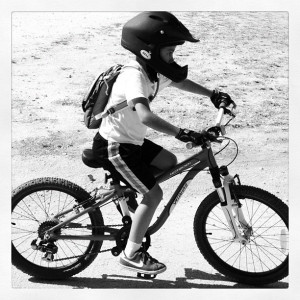Kids go where no adult dares: They act without fear, eat what they shouldn’t, and fall asleep almost anywhere. But in all their innocent fun, it seems like they have little sense of the dangers of riding a tricycle, a four-wheeler, a two-wheeler, or a 10-speed.
Bicycling is the number one sport that puts kids in the emergency room, in part because of its popularity. Of these bike-related accidents, almost 50% involve a traumatic brain injury, according to AAA.
However, properly-fitted helmets reduce the risk of brain-related injuries by 88%, says SafeKids Worldwide. Here are a few ideas to get your child to strap on the gear and keep it on.
1. Like father, like son
Children imitate Mom and Dad. For your son or daughter to see a helmet as essential, they have to see you with yours on every time you hop on a bike. If you consistently wear a helmet, it’s more likely you child will. Older siblings are also major authority figures in the eyes of younger siblings, often even more than parents, so get the older kids in on it too. If your child sees both you and older siblings wearing a helmet, it can make a big difference.
Other role models like professional athletes have a powerful influence too. Share with your child the examples of professional bikers who wear helmets, like Chris Clark, a professional stunt cyclist. “Back in the day,” said Chris in an interview with Huffington Post, “helmets weren’t considered cool. But now it’s totally different. The helmets are cool. The designs are cool. That whole dynamic is changing where if you’re on a bike, you have a helmet on. It’s just part of the outfit.” Share Chris’ story with your kids by showing them this video:
2. “Talk to me.”
Open up a dialogue with the family. Ask your child why he or she doesn’t want to wear a helmet. Try to understand where your son or daughter is coming from and empathize with them. Then explain why it is important to you that your child wear the helmet. Express how dangerous it is to risk getting a brain injury and what the potential consequences are. In the words of traumatic brain injury specialist Dr. James Young at Rush University Medical Center: “Your brain is the single most important organ system in your body, and it cannot be replaced. So it should be your top priority to keep it safe.”
3. Make helmets kid-friendly.
There are several things you can do so the helmet is your child’s own choice and something he can have fun with. For example, let him choose the helmet. Toys R Us has some creative ones, and there’s even a variety of helmets for toddlers so they can get into the helmet-wearing habit early on. You can also encourage other neighborhood parents to have their children wear helmets. Safety is a community issue, so don’t be afraid to speak up.
4. Build boundaries, set rules.
Institute a rule against riding without a helmet, and reward your child when she wears a helmet of her own accord. For example, you might offer you daughter a trip to the movies on the weekend if she wears her helmet every day for a week. Or tell your son that he can have some friends over for bike-riding if they all promise to gear up.
 Of course, kids have their own ideas of how to get themselves or their friends to wear a helmet. One older study from the Consumer Product Safety Commission showed that children are actually very aware of the danger of riding without a helmet, even if it doesn’t sink in. As one child said: “You could have serious brain damage and you might have to learn all you know all over again.” It is the tightness, the discomfort, the un-coolness of helmets that often keeps kids from strapping the hard hat on.
Of course, kids have their own ideas of how to get themselves or their friends to wear a helmet. One older study from the Consumer Product Safety Commission showed that children are actually very aware of the danger of riding without a helmet, even if it doesn’t sink in. As one child said: “You could have serious brain damage and you might have to learn all you know all over again.” It is the tightness, the discomfort, the un-coolness of helmets that often keeps kids from strapping the hard hat on.
However, creative methods, like those mentioned above as well as your own, could prove effective, these kids said. They suggested that parents “show pros wearing helmets and being cool” or give a free pizza to the acquiescent helmet-wearers. One participant suggested an even more stringent method: “Tell them its the law and if they don’t [wear helmets] they will have to eat spinach.”
Regardless of how you convince your little one to protect his or her head, always remember to make sure the helmet fits properly and that your child knows the rules of the road.
Other sources:
http://www.healthychildren.org/English/safety-prevention/at-play/Pages/How-To-Get-Your-Child-To-Wear-a-Bicycle-Helmet.aspx
http://www.helmets.org/kidswear.htm
Top photo courtesy of: Travis Swan
Bottom photo courtesy of: Ines Hegedus-Garcia

